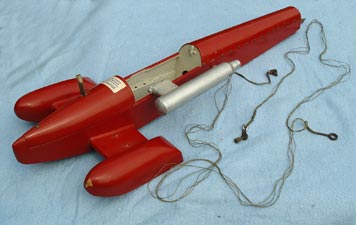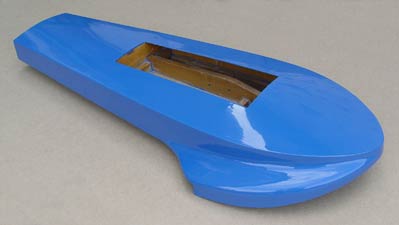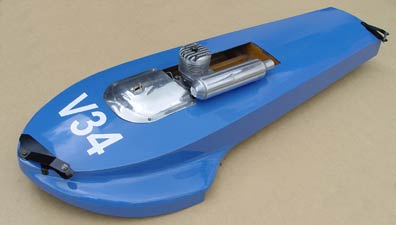

|
Home Updates Hydro's Cars Engines Links Contacts Contact On The Wire Story of Ernie Clark |
V34. Ernie Clark

'Gordon 2'
Previous events had established that 'Gordon 2' might be for sale and following a year of negotiations, a vintage hydroplane enthusiast from the Retro Club became the new owner. As well as 'Gordon', two unknown Clark hulls and a selection of spare parts were transferred between cars in a clandestine meeting at Birchanger Green service area on the M11.
There followed several months of consideration over the best way to proceed with the renovation. The original red paint had been replaced with a very hard and brittle spray finish that had become chipped badly over the years. A hole had been cut in the after deck to allow the skeg to be bolted back on, and other fittings were temporarily attached or missing various elements. Given this, it was decided to go for a complete restoration utilising the parts that were present. Stripping out the hull did not take many minutes and the paint finish was so hard that it came off in huge flakes revealing the true state of the boat.
|
Most obvious were the dozens of screw holes in the bottom where various engine bearers had been fitted leaving very little wood between adjacent holes. Apart from the hole in the deck, the general condition was very good though, so with a lot of rubbing down and filling the hull was ready for priming. There was a problem though as the skeg had to be attached before the hole in the deck could be repaired so the painting had to be tackled in two halves. |
|
|
|
With the hull primed the skeg and prop shaft were installed and a piece of ply scarfed into the rear of the deck. More priming and everything was ready for the final finishing. Several coats of the very finest International paint were applied, again in two halves to give access. All was going well until the masking tape that had protected the engine bay was taken off. Oh dear! Every coat of paint came off as one boat shaped piece of plastic, leaving the undercoat untouched. There had obviously been some interaction between the solvents in the different coats so the whole process was repeated, this time making sure that the undercoat was thoroughly prepared. Happily, all went well this time round. Left: Extended tether bracket to lean boat inwards |
|
The fuel tank was mounted back in its original position and witness marks showed that the engine mounts had been reversed when the boat was prepared for exhibition so these were replaced the correct way round. The only item that did cause some real problems was the fuel 'knock off'. The original arm and mount were there, but the system Clark used was very different. Instead of a valve or tap that turned the fuel off, his version used a tapered plug that pulled out of a tube to stop the motor sucking fuel through. Getting the geometry and other parts exactly right was not easy. |
|
|
|
The motor was, of course a replacement for the original, as was the silencer, but this proved to be nothing more than a dummy as there was no cut out in it for the exhaust. A few minutes on the milling machine soon rectified that. Half of the rear tether bracket was missing, but that was not a major job, and the only other missing piece was the aluminium surround to the engine bay. This had to be cut from one sheet of thin aluminium, flanged and shaped to fit the opening in the hull, yet still allowing the beaten aluminium cowling to fit. That did take a few hours to get it all to fit with no apparent gaps. |
|
A friend with a vinyl cutter produced the lettering for the sides of the hull using the closest match we could find to the original font. An early picture of the boat show VMSC pennants as well as the name, but I suspect these will have to be hand painted or computer generated, unless a Victoria member has a pair of 60 year old transfers lurking somewhere? So ended the restoration of 'Gordon 2', British and European record holder and ME medal winner, but that was not quite the end of the story. Thanks to Gordon Clark and his sister Ann, the original drawings of Gordon's 30cc two-stroke motor have been preserved and they have kindly donated them for future reference. |
|
|
'Anne'? Another of the Clark stable of boats that Norman Lara had purchased from Fred Nail was a small edition of the George Lines ‘Sparky’ design that had been built around 1950. The Hornet motor, sadly, was missing, but the story became more fascinating.
There are very few mentions of Ernie
running C class 10cc boats, but at the South Eastern regatta at
Brockwell Park in May 1951 mention is made of a new and fast boat called 'Anne', carrying on the tradition of naming his boats after his
children. The boat only showed its best performance after the timed run
had finished where it had recorded 40.6mph. |
|
Whilst on the trail of another of Ernie’s boats, it became known that one of his 10cc Hornet motors was still in existence, having again been bought from Fred Nail, but following an article in Model Boats several years ago, it was thought that it may have been for a ‘Patsy’ copy Ernie had also built. Further investigation proved this to be wrong and that it was probably the missing motor from the ‘baby Sparky’.
|
|
This posed the question as to whether it would be possible to reunite boat and engine? After a great deal of negotiation and an exchange of Hornets, the motor was retrieved, and then in November 2008 the boat became available as well. At this stage Ann who, was working her way through mounds of negatives, had found two original photos of the ‘baby Sparky’ in the course of construction. This was an added bonus that was very much appreciated. Left and above photo's by courtesy of Ann Foakes show her brother Gordon with the boat nearing completion. Here a McCoy motor can be seen in the hull |
|
Although these two pictures showed a McCoy engine, it was obvious that the Hornet was the missing engine as everything fitted together exactly, including the holes drilled in the exhaust manifold for the silencer. The boat needed little more than cleaning, and with the addition of new engine bolts, the Hornet was back where it had started around 1950. By another stroke of good fortune, a tobacco tin of props that had also belonged to Ernie Clark contained two beautifully made props from the boat. |
|
Not really a restoration in the accepted sense of the word, but very satisfying none the less. This does leave one unanswered question though, is this the boat named 'Anne'? It would be lovely to be able to confirm this possibility.
 |
 |
Original bridles from multiple strands of flax.
Two unfinished hulls
'Gordon 2' and the baby 'Sparky' above were the only two hulls that survived intact, although there were three others that Fred had sold on. Of these, two were smaller versions of Gordon 2 and Gordon 3, intended for the 10cc 'C' class. Neither of the boats were completed during Ernie's career, but MPBA archivist Peter Hill purchased the second of these, built to the Bob Palmer 'Patsy' design, with a view to completing it and running it in vintage events.
|
|
The hull was painted a rather nauseous light green, rather than Ernie's traditional red, and fitted with a period McCoy motor. Peter ran this boat regularly, but being made predominantly of balsa wood, its light weight, and wide tunnel made it liable to 'taking off' if the water was anything other than completely smooth. Not wanting to run the risk of damaging the boat irreparably, it was exhibited in the tethered hydroplane collection at Pitsea for many years. With the changes taking place there, most of the collection was removed, and 'Patsy' as Peter had named the boat, complete with its original stand and accessory box was passed on. |
The small version of Gordon 2 uses the same 'Ventnor' design principles as its bigger brother, and even larger cousin Campbell's 'Bluebird' K4. The sponsons are faired into the hull sides, unlike the bigger boat, showing similarities with the 'Patsy' and 'Gordon 3' style, suggesting that this was built somewhat later than the others.
The hull was completed and covered with some form of resin to reinforce the construction, yet there was no sign of any attachment points for other fittings. It is slightly odd that neither the skeg or drive shaft were fitted, as these would normally be put in place before the decks were attached.
 |
 |
A new skeg and drive shaft were made and installed, not an easy job in a boat that has already been finished, as getting the shaft in line with an imaginary engine was an adventure. Tether brackets and fuel tank to the same pattern as Gordon 2 were fabricated and a a new coaming beaten up out of sheet aluminium. A set of engine mounts and a period Hornet motor finished building the boat after a gap of some sixty years. Why neither of these two boats were finished is something of a mystery, unless they had reached this stage when Ernie was forced to retire from boating activities?

'Gordon 4' or 'Sylvia'?
The last of the boats retrieved is completely different from all the other, being of catamaran style. The twin hull configuration was popularised by George Stone of the Malden Club who used this type of boat to break the British outright record by nearly 20 mph in 1949 using an engine of just 10cc.
|
There was some suggestion that this might have been 'Gordon 4' but reference to this boat in the Model Engineer turned out to be a printing error. Again, photos from Ann have provide a valuable clue as to its identity as one of these shows a similar boat named 'Sylvia' after another of Ernie's daughters. Although not the same, as the boat pictured is for the 10cc 'C' class with the Nordec engine showing clearly, it is of identical design in every respect other than size. Right. 10cc 'Sylvia' being held by Gordon Clark. |
|
No sign of a name was apparent to give a clue, as the boat had been stripped of all its fittings and then subject to some pretty aggressive treatment with paint remover and a disc sander. This had all been covered with copious quantities of car body filler and orange paint. The hard to get at bits, though, were still the traditional 'Clark red'.
With all the original holes still in the hull, witness marks in the ply and Ann's photo, it has been possible to reverse engineer the skeg, propshaft and drive shaft fitting, engine mounts and raised bridle attachments. Further photographs that have been supplied by Ann showed that the same bridle system Ernie used on 'Gordon 2' to cant it inwards and spill air, was also used on this and other hulls, specifically to overcome the problem of flipping.
With nothing to lose on the paint front, the orange was removed unceremoniously and the whole hull refinished with appropriate undercoat and red top coat. At this stage work stopped while the search went on for a contemporary 30cc two-stroke motor. By one of those strange coincidences that make this hobby so fascinating, Norman Lara came up with a bag of bits that contained most of a engine that his dad had built, almost certainly from a set of Ernie Clark's castings. A lot of work was required on the motor, and Ron Hankins did a superb job with the rebuild. The motor fitted the hull exactly, which must be more than just coincidence? With the motor in place, the tank and aluminium cowling were made to suit, along with a fuel cut off, reverse engineered from existing pieces and reference to photos.
The exhaust system was built with a separate silencer, again as per the photos, and the fact that the hull Had obviously been cut away just to allow room for the manifold. That completed the rebuilding of, well, that was the question, was it another 'Sylvia' or another 'Gordon'? The consensus was that 'Sylvia' and 'Anne' were used for the 10cc boats and 'Gordon' for the 30s so a set of numbers and names were obtained from Steve at Humberston signs and applied. I have no proof that it is 'Gordon 4' and would have liked to think that it was 'Sylvia so that each of Ernie's children have a surviving boat of their father's named after them.
|
|
|
We are most grateful to Norman Lara who
provided the inspiration for these articles as well as much of the hardware. Our
thanks also go to Ernie Clark's daughter Ann and son Gordon for
all their help and the original photographs. It has been an interesting journey,
but thanks to Norman Lara, Peter Hill, Stuart Robinson and Ron
Hankins, the boats of Ernie's that have survived are gathered together and restored to original condition.
©copyrightOTW/09